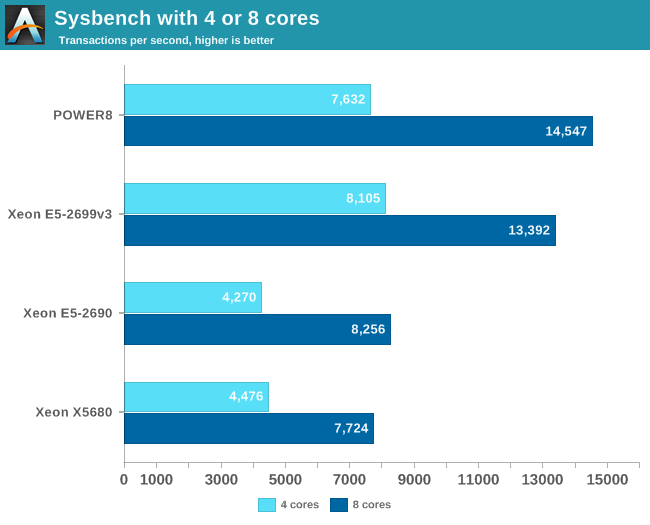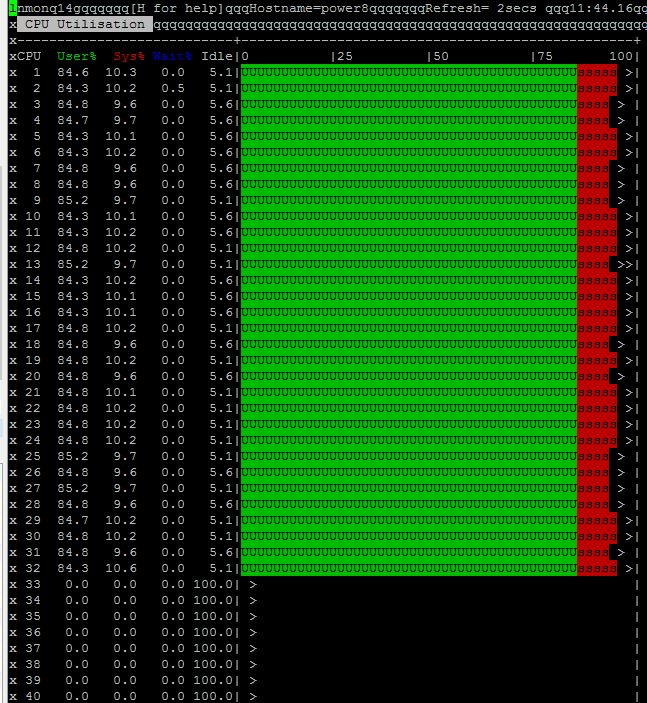The IBM POWER8 Review: Challenging the Intel Xeon
by Johan De Gelas on November 6, 2015 8:00 AM EST- Posted in
- IT Computing
- CPUs
- Enterprise
- Enterprise CPUs
- IBM
- POWER
- POWER8
Database Performance: MySQL
Both MySQL and PostgreSQL do not scale well enough to make use of 72 threads (Dual Xeon E5), let alone 160 threads (Dual POWER8). We installed Percona MySQL Server 5.6, which is the most scalable InnoDB based MySQL server.
We used the MySQL Sysbench benchmark, but we limited MySQL with taskset to run on 4 or 8 physical cores. We verified that this was actually the case by running "nmon" on top of the IBM server.
You can clearly see that the first 32 threads are used (CPU 0 - 7).
Sysbench allows us to place an OLTP load on a MySQL test database, and you can chose the regular test or the read-only test. We chose read only as even with solid state storage, Sysbench is quickly disk I/O limited.
We tested with 10 million records and 100,000 requests. The main reason why we tested with Sysbench is to get a huge amount of queries that only select very small parts (a few or one row) of the tables, Sysbench allows you to test with any number of threads you like, but there is no "think time" feature. That means all queries fire off as quickly as possible, so you cannot simulate "light" and "medium" loads.
The response times are very small, which is typical for an OLTP test. To take them into account, we are showing you the highest throughput at around 3-4 ms. As the results tend to vary a bit, we give you the average of three runs.

With only 4 cores active, the Xeon E5-2699 v3 is still running at 3.3 GHz. Once we use 8 cores, the clockspeed lowers to 2.9 GHz, and the POWER8 outperforms the best Xeon by a small margin. However, we are only testing a part of the CPUs, similar to running only one VM. Ultimately what this means is that total performance will be:
- the POWER8 will be around 36k (14400/8 * 20 cores)
- the Xeon E5-2699 v3 will be around 60k (13400/8 * 36 cores)
- the Xeon E5-2695 v3 will be around 45k (13000/8 * 28 cores)
So the current MySQL performance on top of POWER8 is good, but MySQL runs still a lot better on the Xeons.











146 Comments
View All Comments
Mondozai - Friday, November 6, 2015 - link
That's too bad. Over 90% of the world population exists outside of it and even if you look at the HPC market, the vast majority of that is, too.The world doesn't revolve around you. Get out of your bubble.
bji - Friday, November 6, 2015 - link
He never claimed the world revolved around him, he just made a true statement that may be worth consideration. Your response is unnecessarily hostile and annoying.I would expand Jtaylor1986's statement: I believe that most if not all native English speaking populations use commas for thousands grouping in numbers. Since this site is written in English, it might be worthwhile to stick to conventions of native English speakers.
It's possible that there are many more non-native English speakers reading this site who would prefer dots instead of commas, but I doubt it. Only the site maintainers would know though.
Jtaylor1986 - Friday, November 6, 2015 - link
You read my mind :)mapesdhs - Tuesday, November 10, 2015 - link
Talking to numerous people around Europe about tech stuff, I can't think of any nation from which someone used the decimal point in their emails instead of a comma in this context. I'd assumed the comma was standard for thousands groupings. So which non-US countries do use the point instead? Anyone know?lmcd - Friday, November 6, 2015 - link
Cool on the rest of the world part, but the period vs comma as delimiters in the world numeric system ARE backward. In language (universal, or nearly), a comma is used to denote a pause or minor break, and a period is used to denote the end of a complete thought or section. Applied to numerics, and you end up with the American way of doing it.^my take
JohanAnandtech - Saturday, November 7, 2015 - link
Just for the record, this was not an attempt to nag the US people. Just the mighty force of habit.ZeDestructor - Saturday, November 7, 2015 - link
For future use: just use a space for thousands seperation (that's how I do it on anything that isn't limited to a 7seg-style display), and confuse readers by mixing commas and periods for decimals :Ptygrus - Sunday, November 8, 2015 - link
I like to use a fullstop for the decimal point, an apostrophe for the thousands separator, a comma for separating items in the list, don't start a sentance with a digit.One list of numbers may be : 3'500'000, 45.08, 12'500.8, 9'500. Second list : 45'000, 15'000, 25'000. We use apostrophes when we contract words like don't so why not use it for contracting numbers where we would otherwise have the words thousand, millions, billions etc ?
mapesdhs - Tuesday, November 10, 2015 - link
I have a headache in my eyeballs! :Dws3 - Friday, November 6, 2015 - link
North America is on the majority side on this issue. Asia, in particular, is almost completely on the side of using a dot as the decimal separator and a comma to put breaks in long numbers.Get with the program Europe. The world doesn't revolve around you!